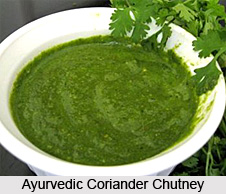 Ayurvedic Coriander Chutney is a vegetable side dish which is loaded with various benefits. The primary ingredients for preparing this chutney are coriander leaves, ghee, black mustard seeds, cumin seeds and some other common spices. Ayurvedic coriander chutney can be served with vegetable sandwich, potato pakora, dhokla, dabeli, samosa, aloo tikki burger. It can easily be prepared at home.
Ayurvedic Coriander Chutney is a vegetable side dish which is loaded with various benefits. The primary ingredients for preparing this chutney are coriander leaves, ghee, black mustard seeds, cumin seeds and some other common spices. Ayurvedic coriander chutney can be served with vegetable sandwich, potato pakora, dhokla, dabeli, samosa, aloo tikki burger. It can easily be prepared at home.
Ingredients of Ayurvedic Coriander Chutney
•One cup of water
•One cup of unsweetened shredded coconut
•Three cups of fresh coriander leaves
•Half green chilli chopped
•One inch piece of fresh ginger peeled and finely chopped
•One tablespoon of ghee
•Half teaspoon of black mustard seeds
•Half teaspoon of cumin seeds
•A pinch of hing
•Fresh lime cut into half
•One-fourth teaspoon of salt
•Four fresh curry leaves
Method of Preparing Ayurvedic Coriander Chutney
To prepare the ayurvedic coriander chutney, remove the coriander leaves from the stem. In a blender, put the coriander leaves, some water, shredded coconut, chilli and ginger and form a liquefied paste. Stir occasionally. On the other hand, heat a saucepan on medium flame and add ghee to it and cumin seeds. After stirring for some time, add mustard seeds, hing and curry leaves. Stir gently until the seeds pop up. Cool and mix them well in the coriander paste. Squeeze the juice of the lime, add salt and stir gently. It is to be stored in cool temperature and used within two to three days.
Benefits of Ayurvedic Coriander Chutney
This chutney ensures various health benefits. The main ingredient which is coriander leaf balances tridosha. People with Pitta dosha might reduce chilli, salt and mustard seeds even though coriander has cooling properties. Other ingredients also have benefits. Ghee is enriched with Vitamins A, D, E, and K. It stimulates the digestive system and increases vitamin absorbency. Cumin is a rich source of iron. It prevents indigestion, flatulence, diarrhoea, nausea and morning sickness. Curry leaves protect gastrointestinal tract, control diabetes, control cholesterol, reduce chemo and radio side effects. Then ginger maintains normal blood circulation, improves absorption, combats stomach discomfort, reduces pain and inflammation, and fights common respiratory problems. But one must consume it at the right time and in right quantity. Too much consumption of anything is never good for health.





